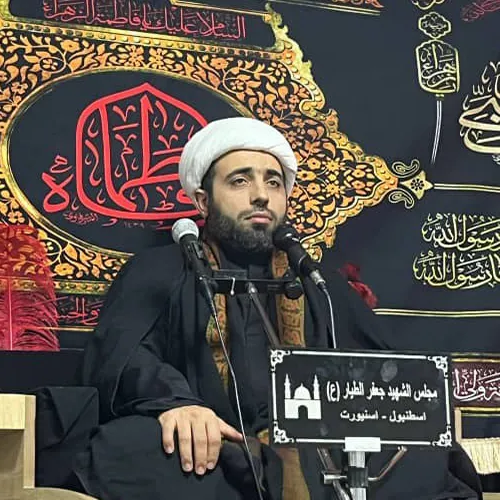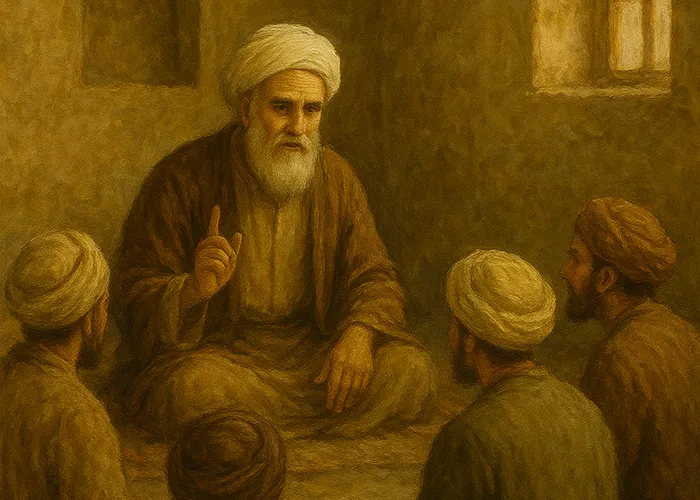Hojjat al-Islam Muslim Khatari
Make your intention for this week’s guest of the bulletin is performing the Ziarat on your behalf.
In this week’s Friday bulletin, we travelled from England to Germany and had a conversation with one of the traveling preachers. Though he is not a permanent Friday prayer leader, his resume includes leading Friday and congregational prayers, as well as engaging in various cultural, promotional, media, and social activities across Islamic and non-Islamic countries.
Hojjat al-Islam Muslim Khatari, who is fluent in German, Arabic, and Persian, has carried out most of his missions in Germany. At the time of this interview, he had the honour of visiting the shrine of Aba Abdullah (Imam Hussein, peace be upon him). From Karbala, he promised to perform a visitation on behalf of you, the readers of this article in the bulletin. Make your intention now: Peace be upon you, O Aba Abdullah!
- First, could you please share in which countries you have carried out your preaching activities and what roles you have had in relation to Friday prayers?
Thanks to God, I have had the opportunity to travel to countries such as Oman, Georgia, Turkey, Germany, Belgium, France, and Iraq for preaching purposes. Due to my fluency in Arabic, I have visited Iraq more frequently, and similarly, my fluency in German has led to more frequent visits to Germany. However, my primary focus has been on Germany.
I have not served as a permanent Friday prayer leader, but in cities such as Leipzig and Hamburg in Germany, I have undertaken responsibilities ranging from leading Friday and congregational prayers to various promotional and cultural activities. These travels have provided me with a wealth of experiences.
- What are the differences between preaching to Muslim communities in European countries and in other countries?
Preaching in European countries, which predominantly involves immigrant communities with multicultural characteristics, is significantly different from countries like Georgia and Turkey, which are Islamic and do not generally exhibit multicultural diversity.
In non-Islamic countries, Shia Muslims are either locals or a small percentage of immigrants who do not differ significantly from the local population. However, in European countries, the primary issue is the phenomenon of migration. A preacher or cultural and religious organization must pay special attention to the multicultural nature of these societies.
In these countries, interaction with various ethnicities, nationalities, languages, and cultures should be the core focus of a preacher’s work. Achieving this interaction requires specific abilities. First and foremost, a preacher must accept the challenges and difficulties of cultural work and interaction with such differences. At the same time, they must gain acceptance from the diverse nations and cultures they engage with.
In my view, by following the example of the lives of the Infallible Imams (peace be upon them), the conduct of a religious preacher in non-Shia countries, considering the minority status of Shias, should strike a balance. It should neither lead to the assimilation and dissolution of the Shia community into the host societies nor result in confrontation and conflict. This is because the Ahlul Bayt (peace be upon them) sought to strengthen the Shia community through these two strategic approaches.
- How do you evaluate Friday prayers in Germany and France, where you have mainly been active? Are there any challenges in this regard?
Unfortunately, the Friday prayers of Shia Muslims in non-capital cities in Germany and France are weak. The main reason for this is the lack of appropriate spaces. For instance, in Strasbourg, France, a well-known city, there are 15 Sunni mosques, one of which is the large Ayub Sultan Mosque. However, Shia Muslims in this city do not have a place, not even a Hussainiya (a Shia community centre). Sometimes, to preach in this city, we are forced to hold congregational prayers in an auto body repair workshop or rent a hall in a church. The situation is similar in other cities as well.
In addition to the concern of a lack of suitable spaces, the second major challenge is the shortage of preachers and prayer leaders. Non-Shia communities, on the other hand, have access to considerable resources due to the support they receive. Smaller challenges, such as working hours and the days of the week, also have an impact, though they are less significant.
- What is the biggest challenge and the primary need of the Muslim community in Europe today? What is the solution?
In the previous question, I mentioned the lack of suitable spaces and preachers as two main challenges in the context of Friday prayers. However, there is a bigger challenge that is not easily solvable, which is the lack of trust among people towards those in charge of securing funds for the construction of mosques and religious centres. In some past cases, the performance of certain individuals and officials in charge of these centres has not been positively evaluated, which has led to a lack of public participation.
The solution to this problem is that representatives of religious authorities, or a trusted individual appointed by them, should be assigned to oversee these centres. Additionally, training preachers within European countries, who have local characteristics and are at least fluent in the native languages, Persian, Arabic, and even Turkish in countries like Germany, is essential. The second step is to officially register these organizations and Hussainiyas, which could help resolve funding and even space issues by collaborating with churches and government institutions.
Active participation, study and awareness, and the use of art are three key strategies to combat Islamophobia.
- What is the primary responsibility of a Friday prayer leader in European countries, considering the rise of Islamophobia?
The primary responsibility of a Friday prayer leader in non-Islamic countries, which requires a deeper understanding and more interaction with the community, is first and foremost a serious presence in social gatherings and an understanding of the local society where they are preaching. Interestingly, during my travels to Europe, I personally witnessed that non-Muslims are utilizing this strategy to preach and attract audiences. Platforms other than Friday prayers and mosques, or outside of religious centres, such as public gatherings, tend to have more appeal and acceptance.
As part of this approach, it is essential to be present in public media and on personal social media pages, seen in a tangible and approachable way, regardless of attire. This presence helps build trust, engagement, and a better understanding of Islam within the broader society.
One of the other important qualities of a Friday prayer leader in combating Islamophobia is studying and understanding the community, staying updated with news, and being well-informed. Unfortunately, some colleagues rely on memorization, obvious facts, and generalities when addressing the issue, whereas it is necessary to reverse-engineer the media tactics used in Islamophobia and respond with the same methods of awakening and enlightenment.
To clarify this important point, I refer to the Church’s response when “Churchophobia” emerged. The Church also adopted the same tactics as its opponents in utilizing media and art. Opponents of the Church used art and media to undermine its influence, but the Church revived itself by using six forms of art before the Renaissance and the seventh form after the Renaissance. By applying the same methods as its adversaries, the Church was able to fight Churchophobia and ultimately succeed.
So, to summarize, I suggest three necessities in response to your question: First, active presence outside the mosque, workplace, or religious space. Second, studying the topic of Islamophobia. And third, combating Islamophobia using art.
Additionally, encouraging women to form home-based groups and create religious women’s organizations is also a valuable suggestion.
- As a preacher or Friday prayer leader during your travels, what creativity and new ideas have you applied that would be worth sharing with your colleagues?
I didn’t come up with any specific new ideas on my own, but during each mission, I emphasized two main strategies. First, encouraging women, as the primary educators of children, to attend home-based sessions and organize their own gatherings at home. Second, promoting the creation of women’s organizations or cultural and religious NGOs by women themselves, allowing them to create an environment that supports their children’s development from an early age.
One of the efforts that received more positive feedback than my presence in mosques or religious centres in Europe was establishing warm connections and organizing retreats for youth and teenagers on their day off. I tried to build closer relationships with young people in their work and living environments. For example, after one Ramadan, we planned a special event for young people who were fasting for the first time or didn’t have much experience. To honour their fasting, we organized a fun day after Eid al-Fitr. Many parents and families gathered the day before the retreat and expressed their desire to participate as well. As a result, at their own expense, we organized a full-day retreat in the city of Leipzig, Germany, which was both joyful and free from any wrongdoing. It became a memorable experience for everyone.
editor's pick
news via inbox
Subscribe to the newsletter.




